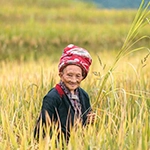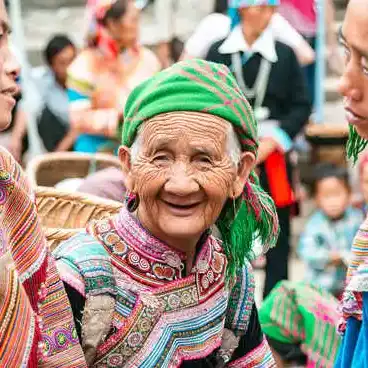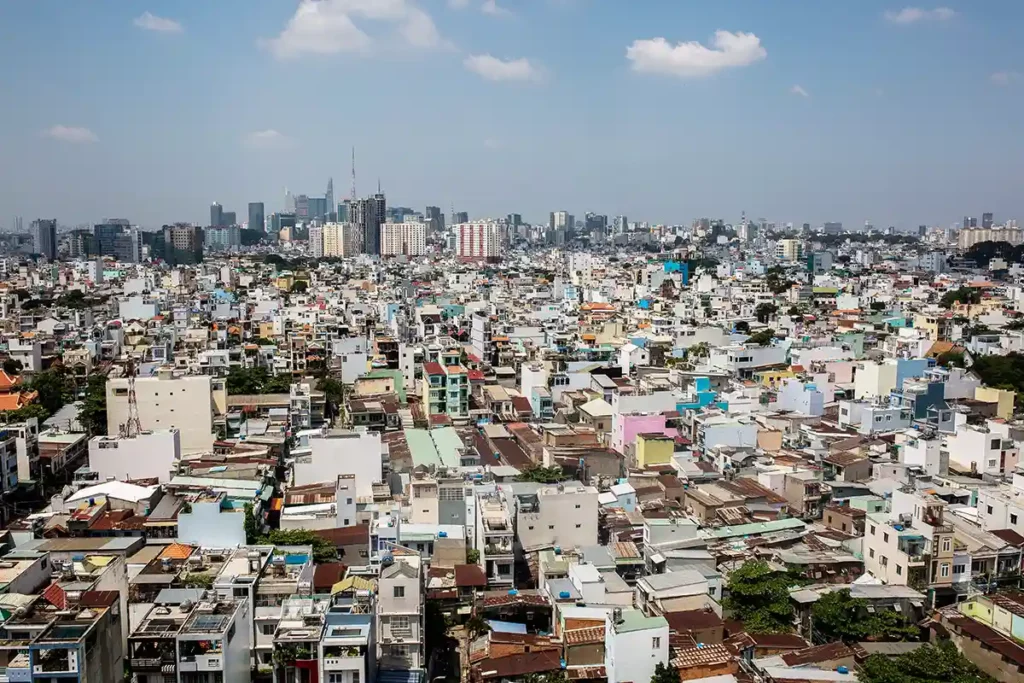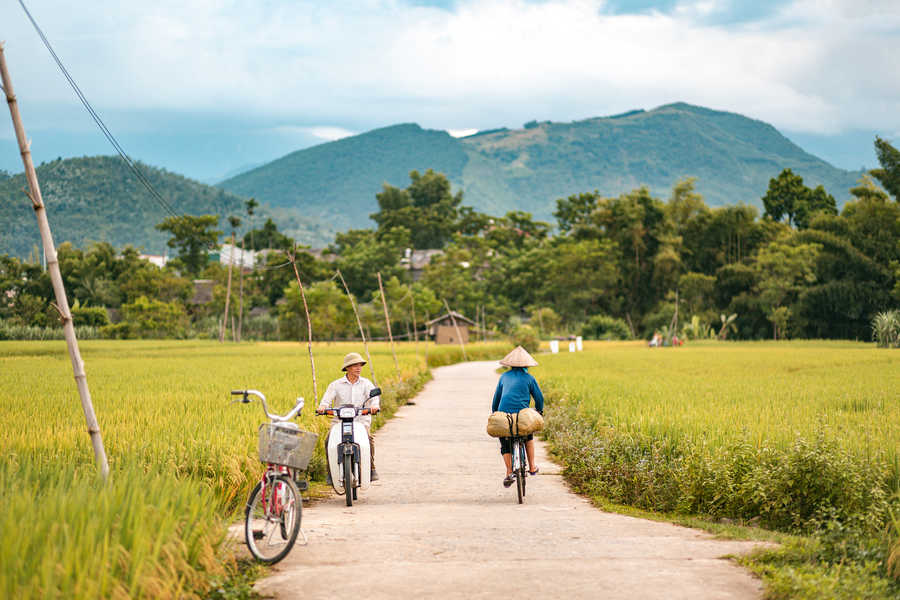Vietnam, a dynamic and rapidly developing country in Southeast Asia, is home to over 100 million people as of 2024. The country has made tremendous strides in economic growth, education, and infrastructure, which has reshaped the lives of its citizens.
Analyzing Vietnam’s population statistics, such as its size, structure, and distribution, provides critical insight into the country’s social development, government policies, and future trajectory. In this article, we’ll explore key aspects of the Vietnam population, including its density, growth rate, age distribution, and more, answering whether Vietnam is a good place to live in 2024.
Total population of Vietnam in 2024
As of late 2023, Vietnam’s population reached an estimated 100.3 million people. This marks a significant increase compared to the last decade. In 2009, Vietnam’s population was 89.9 million, which means an increase of 10.4 million people over the past 14 years. This gives Vietnam an average annual growth rate of 1.14%, which remains modest but steady.
The gender distribution of the population is nearly balanced, with men accounting for 49.8% and women 50.2%. This parity is significant, as it reflects a stable and balanced demographic. The majority of the population resides in rural areas, although urbanization is on the rise, which we’ll explore further.
Vietnam population by age group
A closer look at the Vietnam population by age group in 2024 reveals a youthful yet aging population. The country has a relatively young demographic profile, with about 24% of the population under the age of 15. However, Vietnam is also experiencing the effects of an aging population, as around 12% of the population is over the age of 65.
The working-age population (15-64 years old) makes up the bulk of Vietnam’s demographics, which is a positive sign for its economy. However, the increasing number of elderly citizens is putting pressure on the social welfare and healthcare systems.
Average life expectancy in Vietnam
The average life expectancy of Vietnamese citizens in 2023 was 73.7 years, with women living longer (76.5 years) compared to men (71.1 years). While this is a strong indicator of general health and quality of life, Vietnam still trails behind some of its regional neighbors like Singapore (83 years), Brunei (78 years), and Thailand (76 years).
Vietnam’s life expectancy has shown a steady increase since the 1970s when the average was around 60 years. Major health interventions over the past few decades have played a key role in this improvement. The introduction of universal healthcare, the expansion of vaccination programs, and improvements in maternal and child health have all contributed to lowering infant mortality and boosting overall life expectancy.
In the 1990s, life expectancy grew to around 65 years, reflecting the end of the Vietnam War, as well as recovery efforts and the opening of the economy through the Đổi Mới reforms. Economic growth during this period improved the standard of living for many citizens, facilitating better access to nutrition and healthcare.
Later, in 2000s and 2010s, life expectancy continued to climb as Vietnam invested in its healthcare system, expanding public hospitals and medical facilities. Vaccination programs against diseases such as polio, measles, and tuberculosis became widespread, drastically improving public health.
Despite the steady increase in life expectancy, Vietnam faces challenges that could impact future gains. The country has an aging population, and as more citizens live longer, there will be a growing need for aged care services, long-term healthcare solutions, and chronic disease management. Environmental pollution, particularly in urban centers, and lifestyle-related health problems such as obesity and smoking also pose risks to long-term life expectancy improvements.

Average life expectancy evolution in Vietnam.
Causes of death in Vietnam
Health challenges remain significant in Vietnam, with 90.9% of deaths attributed to illness, emphasizing the ongoing need to improve healthcare infrastructure and disease prevention measures. Non-communicable diseases (NCDs) like cardiovascular diseases, cancer, chronic respiratory diseases, and diabetes are among the leading causes of death in Vietnam, reflecting global trends as the country continues to develop economically. The rise in hypertension and obesity, linked to changing diets and sedentary lifestyles, has contributed to the increased prevalence of these conditions.
Cardiovascular diseases (heart disease and stroke) are a primary contributor to the high illness-related death rate, with heart disease accounting for around 30% of all deaths. Cancer is another major cause of mortality, particularly lung, liver, and stomach cancers. This is exacerbated by high rates of smoking, particularly among men, and environmental factors like air pollution. Chronic respiratory diseases, including COPD (chronic obstructive pulmonary disease), are a significant concern, influenced by smoking and exposure to air pollution, especially in urban areas like Hanoi and Ho Chi Minh City.
In addition to illness, traffic accidents accounted for 4.3% of deaths, which reflects the country’s traffic safety issues. Vietnam has one of the highest rates of road fatalities in Southeast Asia, primarily due to motorbike accidents, as motorcycles remain the most common mode of transport. Helmet use, while mandated, is not always consistently enforced, and speeding, drunk driving, and poor road conditions contribute to the high accident rates.
Work-related accidents caused 1.1% of fatalities, indicating that workplace safety remains a challenge, particularly in sectors like construction, manufacturing, and mining. As the country continues to industrialize, there is a need for stronger regulatory frameworks and enforcement of occupational safety standards to protect workers from hazardous environments.
Population distribution by household
Vietnam also saw considerable changes in household composition. As of April 2021, the country had about 27.2 million households, of which 10.5 million were located in urban areas, accounting for 38.7%, while 16.7 million (61.3%) households were in rural regions. The average size of a household nationwide is 3.5 people, reflecting typical family structures.
This urban-rural divide is a key factor in understanding living standards, as urban areas tend to offer more access to modern infrastructure, healthcare, and education.
Vietnam population density: how crowded is it?
Vietnam’s population density stands at 321 people per square kilometer in 2024, up from 297 people per square kilometer in 2019. This makes Vietnam the third most densely populated country in Southeast Asia, following the Philippines (363 people/km²) and Singapore (8,292 people/km²).
The density varies dramatically by region. The Red River Delta in the north and the Southeast region, home to Ho Chi Minh City, are the most densely populated areas, with 1,060 people/km² and 757 people/km², respectively. The density in these regions highlights the rapid urbanization and industrial development that have attracted millions of people from rural provinces.

Source : Britannica Kids
Urban and rural population distribution
Urbanization in Vietnam continues at a brisk pace, but rural areas still dominate in terms of population. As of 2023, only 37.1% of the population resides in urban areas, while the remaining 62.9% live in rural regions. This divide reflects the slower pace of urbanization compared to some other Southeast Asian nations.
While cities like Hanoi and Ho Chi Minh City continue to grow, the country’s rural areas remain crucial, especially for agriculture. However, migration to urban areas is slowing down, particularly due to increasing living costs and the government’s efforts to improve living conditions in rural areas.
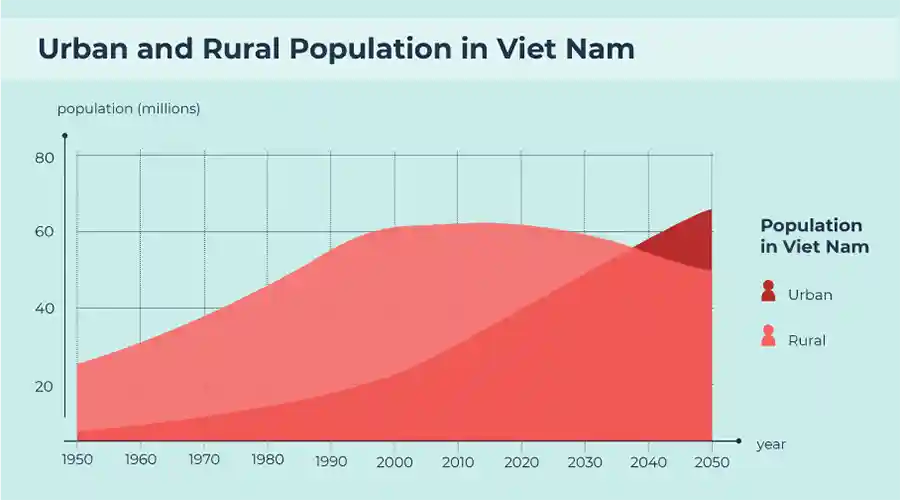
Urban and rural population in Vietnam. Source : Urbanet
Ethnic composition of Vietnam’s population
Vietnam is home to 54 officially recognized ethnic groups, though the majority of the population belongs to the Kinh ethnic group, which accounts for 85.4% of the population, or around 78.32 million people. The remaining 14.6% of the population comprises 53 minority ethnic groups.
While the Kinh dominate the country’s urban centers and economic hubs, ethnic minorities primarily reside in rural, often mountainous, regions. The Vietnamese government has implemented several policies to improve living conditions for minority groups, but these populations still face economic and educational challenges in comparison to the Kinh majority.
Religious demographics
Vietnam’s religious landscape is diverse. As of 2023, approximately 13.2 million Vietnamese people practice a religion. Catholicism is the most widely followed religion, with 5.9 million adherents (44.6%), while Buddhism, which has historically played a significant role in Vietnamese culture, accounts for 4.6 million followers (35%).
While Vietnam is officially a secular state, religion still plays an important role in the cultural and spiritual life of many Vietnamese, especially in rural areas. Religious tolerance is generally high, and the government oversees religious practices to maintain social harmony.

Pie Chart of Religions in Vietnam. Source : CleanPNG
Migration patterns in Vietnam
Migration remains a crucial part of the Vietnamese population landscape, especially the migration from rural to urban areas. In 2024, about 13.6% of the population were migrants, with the majority moving to urban areas in search of better economic opportunities. The Southeast, home to Ho Chi Minh City, is the most attractive region for migrants, accounting for more than two-thirds of internal migration.
On the international front, Vietnam has the second-largest number of migrant workers in Southeast Asia, many of whom work abroad in countries like Japan, South Korea, and Taiwan, sending remittances back home. These countries offer relatively high wages, especially in sectors such as construction, manufacturing, agriculture, and caregiving. In Japan, the Technical Intern Training Program (TITP) has been particularly popular, attracting a large number of Vietnamese workers seeking vocational training and employment opportunities. In South Korea, under the Employment Permit System (EPS), many Vietnamese work in factories and farms, while Taiwan also remains a key destination, especially for domestic workers and caregivers.
One of the most significant impacts of overseas migration is the flow of remittances back to Vietnam. In 2023, remittances from Vietnamese workers abroad were estimated to be around $19 billion, accounting for a considerable portion of the country’s GDP. These funds provide essential financial support to families, particularly in rural areas, and contribute to improving living standards, funding education, healthcare, and even local business ventures. Remittances also help alleviate poverty and reduce income inequality, particularly between urban and rural areas.
Education in Vietnam
Vietnam’s education system continues to perform well, with a near-universal enrollment rate for primary school students. At the start of the 2023-2024 school year, 99.7% of eligible students were enrolled in school. By the end of the school year, 98.17% of students successfully completed primary school.
For upper secondary education (grades 10-12), the net enrollment rate is slightly lower but still above 80%. Completion rates at the secondary level are lower than primary, with some students leaving school to join the workforce or due to economic constraints, especially in rural areas.
Enrollment in higher education (universities and colleges) has been steadily increasing. In 2022, over 2.5 million students were enrolled in higher education institutions across the country. The growth is fueled by the government’s push for developing skills in STEM (Science, Technology, Engineering, and Mathematics), which is seen as critical for Vietnam’s future economic growth.
The government’s commitment to improving education quality has contributed to rising literacy rates and a well-educated young population, making Vietnam more competitive in the global labor market. The government of Vietnam allocates approximately 20% of its national budget to education. This substantial investment has helped in improving infrastructure, training teachers, and providing resources such as textbooks and technology, particularly in rural and remote areas.
Vietnamese students are today among the top in Southeast Asia when it comes to studying abroad. In fact, Vietnam consistently ranks as one of the leading countries in terms of the number of students pursuing education overseas. As of recent estimates, over 190,000 Vietnamese students are studying in various countries across the globe, with popular destinations including the United States, Australia, Japan, South Korea, and Singapore.
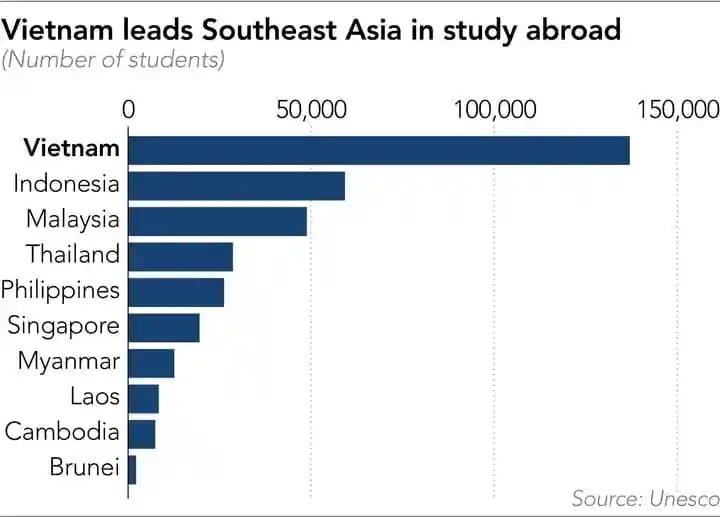
Number of Vietnamese studying abroad. Source : Vietnam Net
Unemployment and labor market in 2024
Vietnam’s unemployment rate remains low, with just 2.26% of the working-age population unemployed in the first nine months of 2024. The unemployment rate is slightly higher in urban areas (2.55%) compared to rural areas (2.07%).
However, the labor market faces sustainability challenges, particularly with the high proportion of informal employment. As of the third quarter of 2024, 63.9% of the employed workforce worked in informal jobs. The government’s efforts to formalize more of the economy and ensure better working conditions are critical to improving the long-term outlook for labor in Vietnam.
Conclusion : Is Vietnam a good country to live in?
The Vietnamese government has been proactive in managing population growth, migration, and urbanization. Policies aimed at family planning and rural development have helped stabilize population growth and reduce poverty in many areas. The government is also focusing on improving healthcare, education, and living conditions for both urban and rural populations.
In terms of migration, the government is working to improve living standards in rural areas to curb the rural-to-urban exodus and reduce overcrowding in major cities.
Based on the comprehensive data regarding its population and government policies, Vietnam is positioning itself as a country with significant potential for growth and quality of life. The nation boasts a young, vibrant population, a low unemployment rate, and a strong educational foundation, all of which contribute to its appeal. Urbanization is driving economic development, while the government’s efforts to address rural challenges are improving living standards across the country.
However, despite its progress, Vietnam still faces challenges such as overcrowding in urban areas, healthcare disparities, and a large informal workforce. Continued efforts to improve healthcare, labor conditions, and infrastructure are essential to ensure that the benefits of Vietnam’s economic growth are felt by all.
For more detailed information about Vietnam’s population and economic data, visit these ressources.
If you’re considering Vietnam as a destination to explore its culture, economy, and social life, you can create your voyage for exploring the life of Vietnam with us !




